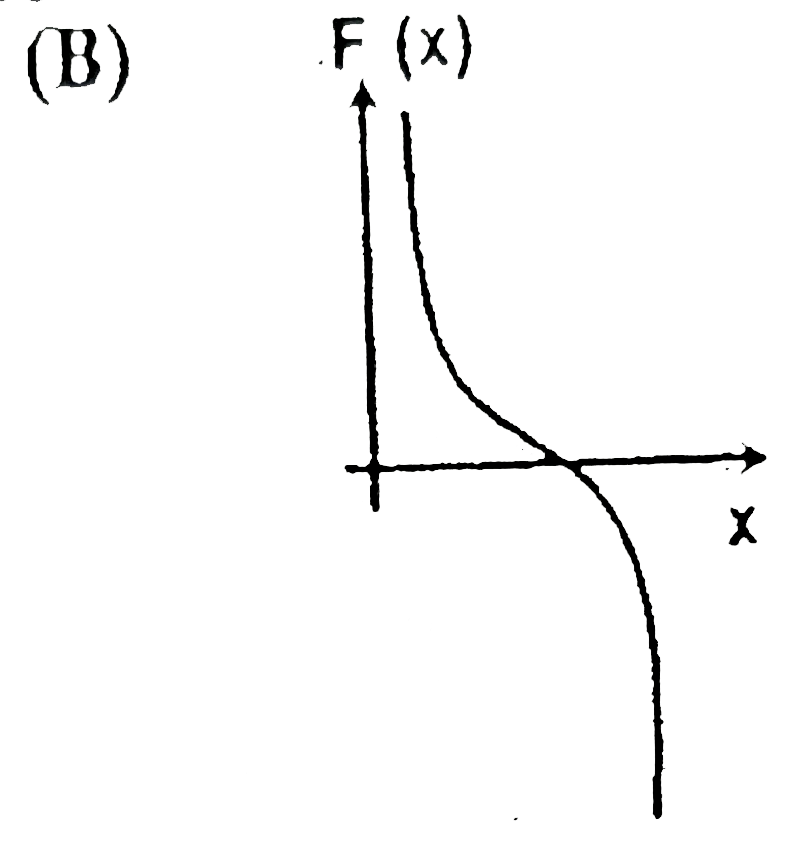The potential energy function for the force between two in a diatomic molecule can approximately be expressed as U(x)=ax12−bx4, where a and b are positive constants, and x is the distance between the atoms. Answer the following question by selecting most appropriate alternative.
The graph between force between the atoms [F(x)] vs x will be




To solve the problem, we need to analyze the potential energy function given and derive the corresponding force function. The potential energy function is given by:
U(x)=ax12−bx4
Step 1: Derive the Force Function
The force F(x) can be derived from the potential energy function using the relation:
F(x)=−dUdx
Now, we differentiate U(x):
1. Differentiate ax12:
ddx(ax12)=−12⋅ax13=−12ax13
2. Differentiate −bx4:
ddx(−bx4)=4⋅bx5=4bx5
Combining these results, we have:
F(x)=−(−12ax13+4bx5)=12ax13−4bx5
Step 2: Analyze the Behavior of the Force Function
Now, we need to analyze the behavior of F(x) as x approaches different limits.
1. As x→0:
- The term 12ax13 approaches +∞ (since a is positive).
- The term −4bx5 also approaches −∞.
- Therefore, F(x)→+∞.
2. As x→∞:
- Both terms 12ax13 and −4bx5 approach 0.
- Therefore, F(x)→0.
3. Finding the Point Where F(x)=0:
- Set F(x)=0:
12ax13−4bx5=0
- Rearranging gives:
12ax13=4bx5⟹12a=4b⋅x8⟹x8=3ab
- Thus, there exists a non-zero value of x where F(x)=0.
Step 3: Conclusion on the Graph of F(x)
From the analysis:
- F(x)→+∞ as x→0
- F(x)=0 at some finite x
- F(x)→0 as x→∞
This implies that the graph of F(x) will start from +∞, decrease to zero at a certain point, and then approach zero again as x increases.
Final Answer
The graph of the force F(x) vs x will have the following characteristics:
- Starts from +∞ when x is close to 0
- Crosses the x-axis at a certain point (where F(x)=0)
- Approaches 0 as x approaches ∞
Thus, the most appropriate alternative for the graph is option A (as described in the video).
The force F(x) can be derived from the potential energy function using the relation:
ddx(ax12)=−12⋅ax13=−12ax13
ddx(−bx4)=4⋅bx5=4bx5
Now, we need to analyze the behavior of F(x) as x approaches different limits.
- The term 12ax13 approaches +∞ (since a is positive).
- The term −4bx5 also approaches −∞.
- Therefore, F(x)→+∞.
- Both terms 12ax13 and −4bx5 approach 0.
- Therefore, F(x)→0.
- Set F(x)=0:
12ax13−4bx5=0
- Rearranging gives:
12ax13=4bx5⟹12a=4b⋅x8⟹x8=3ab
- Thus, there exists a non-zero value of x where F(x)=0.
From the analysis:
- F(x)→+∞ as x→0
- F(x)=0 at some finite x
- F(x)→0 as x→∞
The graph of the force F(x) vs x will have the following characteristics:
- Starts from +∞ when x is close to 0
- Crosses the x-axis at a certain point (where F(x)=0)
- Approaches 0 as x approaches ∞
Topper's Solved these Questions
Similar Questions
The potential energy function for the force between two in a diatomic molecule can approximately be expressed as U(x)=ax12−bx4, where a and b are positive constants, and x is the distance between the atoms. Answer the following question by selecting most appropriate alternative.
The graph between potential energy vs x will be
View SolutionThe potential energy function for the force between two in a diatomic molecule can approximately be expressed as U(x)=ax12−bx4, where a and b are positive constants, and x is the distance between the atoms. Answer the following question by selecting most appropriate alternative.
The dissociation energy of the molecule is (initially molecule is at rest at equilibrium)
View SolutionThe potential energy function for the force between two atoms in a diatomic molecule is approximately given by U(x)=ax12−bx6 where a and b are constant and x is the distance between the atoms. Find the dissoociation energy of the molecule which is given as D=[U(x−∞)−Uatequilibrium]
View SolutionThe potential energy between two atoms in a molecule is given by U(x)=ax12−bx6, where a and b are positive constants and x is the distance between the atoms. The atom is in stable equilibrium when
View SolutionThe potential energy between two atoms in a molecule is given by
U=ax2−bx2
where a and b are positive constants and x is the distance between the atoms. The atom is in stable equilibrium when x is equal to :−
View SolutionThe potential energy function for a diatomic molecule is U(x)=ax12−bx6. In stable equilibrium, the distance between the particles is .
View SolutionA particle located in one dimensional potential field has potential energy functionU(x)=ax2−bx3, where a and b are positive constants. The position of equilibrium corresponds to x equal to
View SolutionA particle located in a one-dimensional potential field has its potential energy function as U(x)ax4−bx2, where a and b are positive constants. The position of equilibrium x corresponds to
View SolutionA particle of mass m is present in a region where the potential energy of the particle depends on the x-coordinate according to the expression U=ax2−bx, where a and b are positive constant. The particle will perform.
View SolutionA potential energy function for a two-dimensional force is the form U=3x2y−7x. Find the force that acts at the point (x,y).
View Solution
